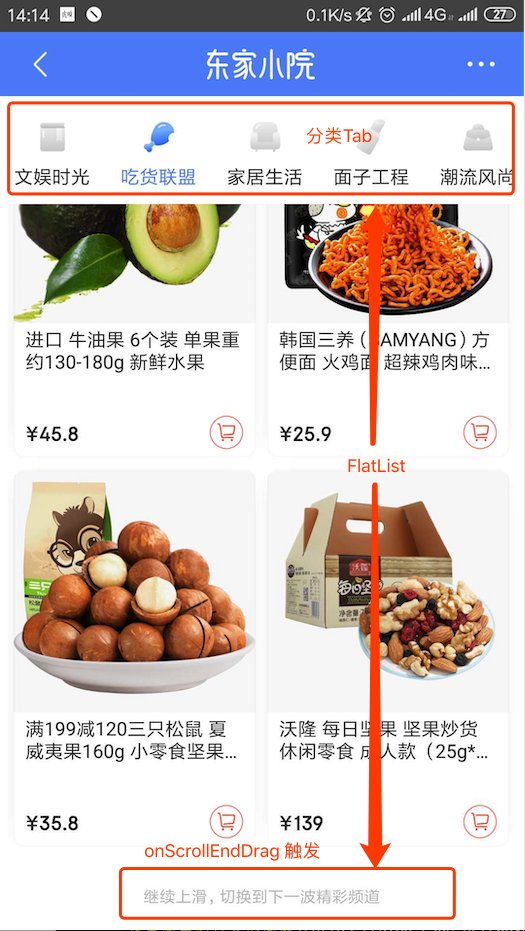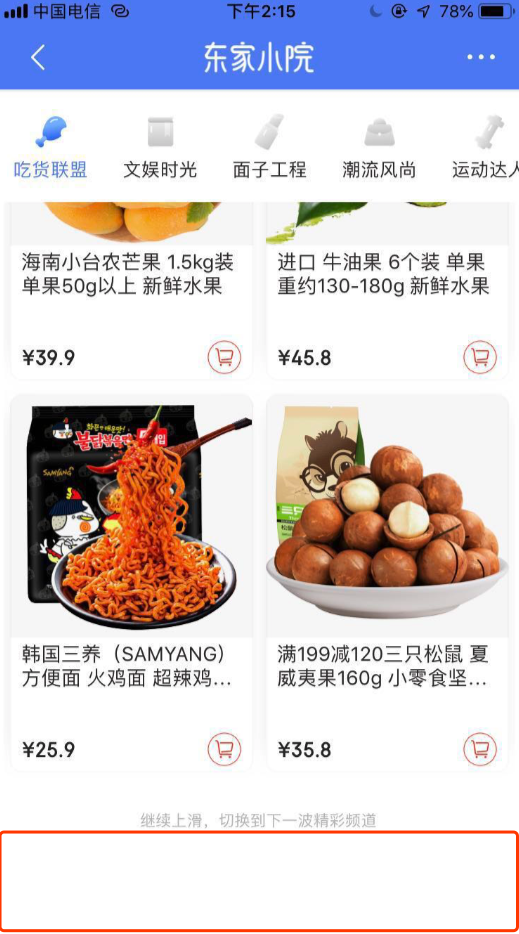- 记录
React Native 中如何实现下拉自动切换分类
- 针对 IOS 和 Android 平台差异,给出不同的切换分类触发条件
需求描述
如图所示,整体为 FlatList,顶部分类栏吸顶,底部为 feed 流。要实现下拉商品列表到底后,继续下拉,自动切换到一下个分类的效果。

实现原理
代码层面,可以在 FlatList 的 onScrollEndDrag 中添加自动 Tab 切换函数,借助 FlatList 实例的内容区高度 contentLength,滑动偏移量 offset 和可视区高度 visibleLength 三者关系,实现下拉自动切换Tab功能。
代码实现
IOS 平台实现
1
2
3
4
5
6
7
8
9
10
11
12
13
14
15
16
17
18
19
20
21
22
23
24
25
26
27
28
29
|
<FlatList
data = {[{banner:[]},{tab:[]},{goodList:[]}]}
renderItem={this.renderItem}
stickyHeaderIndices={(Platform.OS !== 'web')?[1]:null}
ListFooterComponent={this._renderFooter}
onScroll={this._onScroll}
ref={this._setScrollRef}
keyExtractor = {(item, index) => { `hScrollView-${index}` }}
refreshing={this.state.isRefreshing}
onRefresh={this._onRefresh.bind(this)}
getItemLayout={(data, index) => (
{length: 305, offset: 305 * index, index}
)}
onScrollEndDrag = {()=>{
if(Platform.OS != 'web'){
this._onScrollEndDragFun();
}
}}
/>
_setScrollRef = (ref) => {
this._secondGoodFlatListRef = ref;
};
|
1
2
3
4
5
6
7
8
9
10
11
12
13
14
15
16
17
18
19
20
21
22
23
24
25
26
27
28
29
30
31
32
33
34
35
36
37
38
39
40
41
42
43
44
45
46
47
48
49
50
51
52
53
54
| import isEmpty from "lodash/isEmpty";
import {Platform} from "react-native";
import {JDDevice} from "@jdreact/jdreact-core-lib";
_onScrollEndDragFun = (e) => {
let scrollMetrics = (this._secondGoodFlatListRef && this._secondGoodFlatListRef._listRef
&& this._secondGoodFlatListRef._listRef._scrollMetrics) || null;
let {contentLength = 0, offset = 0, visibleLength = 0} = scrollMetrics;
if (contentLength && offset && visibleLength) {
let {selectedIndex = 0} = this.state;
let {tabListData = []} = this.props;
if (!isEmpty(tabListData) && (selectedIndex + 1) < tabListData.length) {
let item = tabListData[selectedIndex + 1];
if (Platform.OS === 'ios') {
if (offset + visibleLength > contentLength + JDDevice.getRpx(100)) {
this._secondGoodFlatListRef.scrollToIndex({
animated: false,
index: 0,
viewOffset: 1,
viewPosition: 0
});
this.ItemCategory._clickCategoryTab2 && this.ItemCategory._clickCategoryTab2(item, selectedIndex + 1);
}
} else {
if (offset + visibleLength > contentLength - JDDevice.getRpx(10)) {
this._secondGoodFlatListRef.scrollToIndex({
animated: false,
index: 0,
viewOffset: 1,
viewPosition: 0
});
this.ItemCategory._clickCategoryTab2 && this.ItemCategory._clickCategoryTab2(item, selectedIndex + 1);
}
}
}
}
};
|
其中,contentLength 为内容区高度,offset 为滑动偏移量,visibleLength 为可视区高度。
关于三种高度定义,可参考 React Native中ListView和ScrollView实现上拉加载
1
2
3
4
5
6
7
8
| let scrollMetrics = (this._secondGoodFlatListRef && this._secondGoodFlatListRef._listRef
&& this._secondGoodFlatListRef._listRef._scrollMetrics) || null;
let {
contentLength = 0,
offset = 0,
visibleLength = 0
} = scrollMetrics;
|
Android 平台实现
对于 Android 平台,当 offset + visibleLength = contentLength 时,表示滑动到底部。为了以前进行切换,对条件进行修正,当滑动到距离底部 10px 时,触发切换 Tab 函数,如下代码所示
1
2
3
4
5
6
7
8
9
10
11
|
if (offset + visibleLength > contentLength - JDDevice.getRpx(10)) {
this._secondGoodFlatListRef.scrollToIndex({
animated: false,
index: 0,
viewOffset: 1,
viewPosition: 0
});
this.ItemCategory._clickCategoryTab2 && this.ItemCategory._clickCategoryTab2(item, selectedIndex + 1);
}
|
对于 IOS 平台,因为 IOS 系统存在弹性上拉,如下图所示。因此对滑动到底条件修正为 offset + visibleLength > contentLength + JDDevice.getRpx(100)。
其中,JDDevice.getRpx(100) 表示弹性上拉的高度,即下图中红色框的高度。

1
2
3
4
5
6
7
8
9
10
11
| if (Platform.OS === 'ios') {
if (offset + visibleLength > contentLength + JDDevice.getRpx(100)) {
this._secondGoodFlatListRef.scrollToIndex({
animated: false,
index: 0,
viewOffset: 1,
viewPosition: 0
});
this.ItemCategory._clickCategoryTab2 && this.ItemCategory._clickCategoryTab2(item, selectedIndex + 1);
}
}
|



